
Identifying Types of Learners
Have you ever found yourself in a situation where you feel you are teaching a child who does not seem to be grasping concepts, despite continuous attempts? Perhaps it is time to change your teaching approach. According to developmental psychologist, Howard Gardner, children do not all possess a general ability when it comes to learning and applying new information. Gardner’s Theory of Multiple Intelligences suggests that each individual child has a unique learning process and technique. Although these techniques have been divided into nine main categories, the following five have been particularly useful for teachers and parents in their attempt to assist improved learning. Verbal-linguistic Intelligence Students are particularly attentive when they are taught using words and language. Their brains understand concepts better when they are presented in verbal form. These children learn by identifying rhythms within words and their sounds. Logical-mathematical Intelligence Students are much more in




